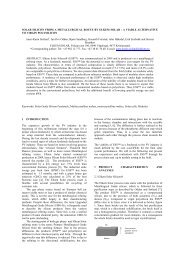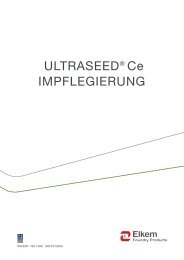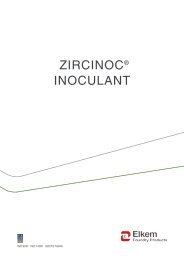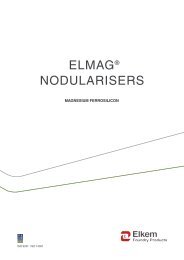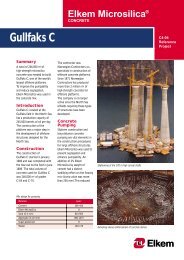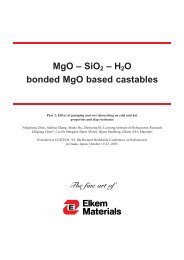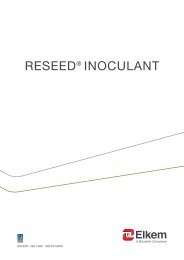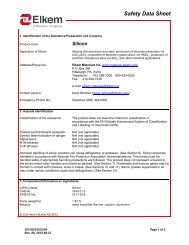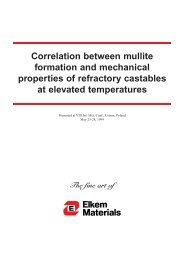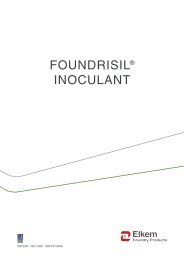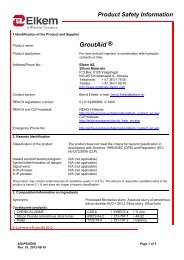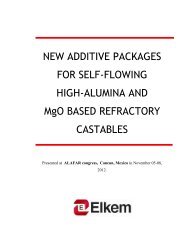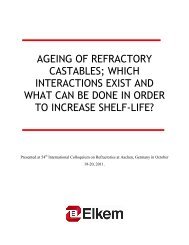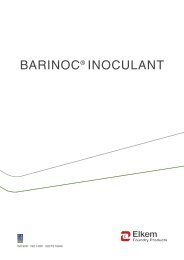SUPERSEED® EXTRA INOCULANT - Elkem
SUPERSEED® EXTRA INOCULANT - Elkem
SUPERSEED® EXTRA INOCULANT - Elkem
- No tags were found...
You also want an ePaper? Increase the reach of your titles
YUMPU automatically turns print PDFs into web optimized ePapers that Google loves.
SUPERSEED ® <strong>EXTRA</strong><strong>INOCULANT</strong>ISO 9001 ISO 14001 ISO/TS 16949
SUPERSEED ® <strong>EXTRA</strong> <strong>INOCULANT</strong>• Maximum chill reduction in grey iron• Promotes evenly distributed random type A graphite• Neutralises nitrogen• Promotes a small graphite flake size, thus minimising graphite pull-outduring machining• Low aluminium content reduces risk of hydrogen pinholes• Effective in grey irons of all sulphur contentsSuperseed® Extra inoculant is a 75% Sibased ferroalloy especially designedfor use in grey iron. The inoculant containsbalanced additions of strontiumand zirconium which are powerful inpromoting type A graphite and reducingthe risk of nitrogen blowholes respectively.By producing the inoculant with adeliberately low aluminium and calciumcontent, the likelihood of hydrogen pinholesand slag generation are minimised.Superseed® Extra inoculant is producedto the following specifications:Chemical SpecificationSilicon 73 – 78%Strontium 0.6 – 1.0%*Zirconium 1.0 – 1.5%Calcium Max 0.1%Aluminium Max 0.5%IronBalance*MSI grades 0.8 – 1.4% SrThe Origin of Superseed ® Extra InoculantSuperseed ® Extra inoculant is producedat the <strong>Elkem</strong> Bremanger plantin Norway and the <strong>Elkem</strong> Chicoutimiplant in Canada, using special productionmethods to ensure maximumuniformity of composition and structurethroughout the product. Both <strong>Elkem</strong>plants have ISO 9001 and ISO 14001accreditations, in addition to ISO/TS16949 certificate for <strong>Elkem</strong> Bremanger.Superseed ® inoculant is recognised allover the world as the leading inoculantfor medium to high sulphur grey iron.<strong>Elkem</strong> realised that a natural developmentof the Superseed ® inoculanttechnology was to extend the range ofsulphur levels that the inoculant couldbe used at, hence the development ofSuperseed ® Extra inoculant. The additionof zirconium to the alloy gives theadditional advantages such as theability to combine with dissolved nitrogenin the iron to reduce the potentialfor nitrogen blowholes and the promotionof a refined type A graphite. Thisleads to a reduction in the promotion ofharmful kish graphite often associatedwith the use of some other powerfulproprietary inoculants and to the type Dgraphite associated with Ti containinginoculants.The excellent chill removal propertiesof Superseed ® inoculant have beenretained in Superseed ® Extra inoculantand even enhanced to include goodchill removal in irons of low base sulphurcontent, irons notoriously difficult toinoculate under normal circumstan ces.An example of the chill removal characteristicsis shown as Figure 1. Thisshows a set of chill wedges cast withSuperseed ® Extra inoculant at low sulphurlevel compared to a conventionalFeSi inoculant.Figure 1: Chill removal with 0.1%Superseed ® Extra inoculant (left) asladle addition compared to 0.1%Foundry Grade FeSi (right) in 0.04%sulphur base iron.Superseed ® is a registered trademark of <strong>Elkem</strong> AS.
Advantages of Superseed ® Extra InoculantFeatures of Superseed ® ExtrainoculantSuperseed ® Extra inoculant is a uniqueand patented formulation that requiresa small amount of reactive elementsto give the maximum effect. This comparesfavourably to more conventionalinoculants which generally containmuch higher levels of reactive elementand may be prone to slag formation.Promotion of randomly distri butedtype A graphiteIn addition to the excellent chill control,even at low sulphur levels, Superseed ®Extra inoculant promotes the formationof an evenly distributed type A graphite.This is because the strontium/zirconiumcombination activates a high number ofnuclei, thus providing a high number ofeutectic cells within the iron, and whichhas the effect of promoting an evendistribution of small graphite flakes.This is achieved with a minimumamount of undercooling and thus thetendency to promote type B and Dgraphite is reduced. These two effectslead to good mechanical properties asshown in the case study.An example of the graphite structuresobtained with Superseed ® Extra inoculantcompared to another ”nitrogenneutralising” inoculant are shown inFigure 2 and are based on work carriedout by the Casting Development Centrein UK. The refined graphite structureobtained with Superseed ® Extra inoculanthas proven beneficial in minimisinggraphite pull-out during machining andthus give a smooth surface finish.Nitrogen controlMany foundries produce medium tohigh nitrogen contents in the base iron.These tend to be either cupola meltedirons or electrically melted irons madefrom high steel scrap charges with largeamounts of recarburiser added to thefurnace. Nitrogen may also be generatedin highly cored castings as a resultof breakdown of the core binders.Nitrogen may be neutralised by the useof titanium or zirconium. Titanium isknown to increase the number of nucleiavailable for graphite precipitation, butas the degree of undercooling is highcompared to zirconium, there is agreater tendency for the formationof undercooled type D graphite andconsequent ferrite formation. This isparticulary relevant as titanium may bepresent in trace quantities from steelscrap used in the melting charge, thusexaggerating the effects. Titanium mayalso be cumulative in certain types ofmelting process.When used to control nitrogen, titaniumforms hard titanium carbonitride particles,Ti(C,N), which are known to bedetrimental to the machinability ofthe iron. There is also a risk that, likealuminium, titanium can promotehydrogen pinholes.Thus the use of zirconium has advantagesover the titanium systems andno cumulative effects have beenreported. Titanium promotes cellstructure refinements by increa singundercooling compared to the strontium/zirconiumrefinement which isachieved by improving nucleation withminimum undercooling. The lattersystem gives much less risk of undercooledgraphite formation, associatedferrite and thus the lack of strength.An example of the nitrogen blowholeprevention is given in Figure 3.This shows a section through an arti ficially high nitrogen iron with bothSuperseed ® Extra inoculant, a titaniumcontaining material and a commerciallyavailable FeSi based material.Combined hydrogen andnitrogen gas holesIt is very common to find gas holeswhich are not caused by either hydrogenor nitrogen alone and these areoften attributed to being caused bya cumulative effect of the two gases.Superseed ® Extra inoculant not onlycontains zirconium to neutralise thenitrogen, but also has low aluminiumcontent compared to most inoculantsto help prevent hydrogen relateddefects.Figure 2: The effect of Superseed ® Extra inoculanton graphite morphology compared to a nitrogenneutralising inoculant.Figure 3: Comparison of nitrogen blowhole defects in 130 ppm grey iron.Left to right: Superseed ® Extra inoculant, Ti bearing inoculant, FG FeSi.
Case StudyThis foundry produces automotivecastings for heavy trucks and tractors.They cupola melt grey irons ata base sulphur content of 0.1% andtypically run a nitrogen blowholesusceptible iron of 110 ppm nitrogen.They compared a high rare earthinoculant, a titanium containing materialand Superseed ® Extra inoculantto achieve a blowhole free iron with atensile strength minimum of 210 MPa.Over an extended test period, the highrare earth containing inoculant failedto achieve the desired chill levels andthe titanium inoculant did not give thedesired minimum tensile properties.With Superseed ® Extra inoculant,the foundry regularly achieved tensileresults of 245 MPa in chill free iron.No nitrogen porosity problems werefound and the graphite morphologywas far more uniform than with theother inoculants.Application of Superseed ® Extra InoculantAs with all inoculants, the effects ofSuperseed ® Extra inoculant will fadewith time after addition to the iron.Superseed ® Extra inoculant shows thecharacteristics of Superseed ® inoculantin having a superior fade time tostandard foundry grade ferrosilicons.Superseed ® Extra is available in bothladle grades and instream size. Thelow reactive element content of theinoculant give it excellent solubility inirons, even at low temperatures.Physical DataStandard SizesStandard PackingApparent Density 3.1 g/cm 3In-stream/MSI0.2 – 0.7 mmBig Bag1050 kg on palletBulk Density 1.75 g/cm 3Small Ladle0.7 – 2 mmBig Bag1500 kg on palletMelting Range1325 °C (liquidus)Larger Ladle2 – 6 mmBig Bag500 kg on pallet1208 °C (solidus)Paper Bag25 kg on palletSteel Drum200 and 220 kg<strong>Elkem</strong> ASFoundry ProductsHoffsveien 65BP.O. Box 5211MajorstuenN-0303, Oslo, NorwayTelephone : +47 22 45 01 00Telefax : +47 22 45 01 52www.foundry.elkem.comRevised April 2012 © Copyright <strong>Elkem</strong> AS



